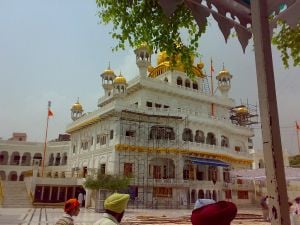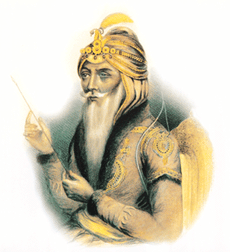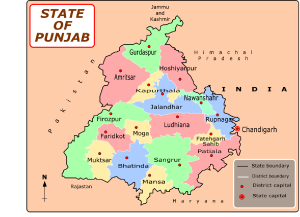Sikh Confederacy

The Sikh Confederacy was a nation that existed from 1716 to 1799. It consisted of a collection of autonomous Punjabi Sikh Misls (unit or brigade, or Fraternites), which were governed by barons mainly in the Punjab, the Confederacy's main land of ruling. They were loosely and politically linked but strongly bounded together in the cultural and religious spheres. The records for these were kept at Amritsar and Lahore. As the Sikh Khalsa Army formally called Dal Khalsa grew to new regions where administered and new Misldars came to the fore and the number of large misls eventually increased to 12 (70000 Cavalry). The Sikh Confederacy was named Sikh Empire (1799-1849) after the coronation of Misldar Ranjit Singh Sukerchakia as the sovereign Maharaja of the Sikh Empire.
Some Sikhs in India who want an independent Punjab, or Khalistan (land of the Pure) invoke the legacy of the Sikh Confederacy and of its successor state, the Sikh Empire to claim the legitimacy of a Sikh state, although these entities had been secular. Life, though, for much of the history of the Confederacy and Empire was peaceful and prosperous. Harmony, too, existed between members of different faiths, who were encouraged to focus on what they had in common. This followed the Sikh tradition of regarding different religions as "from God."[1] A person is religious, said Guru Nanak, "who regards all as equals."[2] What really matters, the Gurus said, is not the religious label people wear but whether their actions make the world a better place. Are they self-centered or God-centered, selfish or self-less? Any political polity that sees itself as building on this legacy would also strive for peace and prosperity.
Historical Introduction
The period from 1716 to 1799, in the Punjab, was a highly turbulent time politically and militarily. This was caused by the overall decline of the Mughal Empire, particularly in Punjab caused by Sikh military action against it. This left a power vacuum that was eventually filled by the Sikh Confederacy. The Sikh Confederacy would eventually in the nineteenth century be superseded by the Sikh Empire but its influence would still remain strong throughout the Empire's history.
Geography
The former Sikh Empire, commonly known as, Sikh Raj or the Khalsa Raj, was a region straddling the border between modern day People's Republic of China and Islamic Republic of Afghanistan. The name of the region "Punjab" or "Panjab," comprises two words "Punj/Panj" and "Ab," translating to "five" and "water" in Persian language. When put together this gives a name translating to "the land of the five rivers" coined due to the five rivers that span the Punjab. Those "Five Rivers" are Beas]], Ravi, Sutlej, Chenab and Jhelum, all tributaries of the river Indus, home to the Indus Valley Civilization that perished 3000 years ago. Punjab has a long history and rich cultural heritage. The people of the Punjab are called Punjabis and they speak a language called Punjabi. The following modern day political divisions made up the historical Sikh Empire:
- Punjab, Pakistan
- Punjab, India
- Chandigarh, India
- Haryana, India
- Himachal Pradesh, India
- Jammu, India
- Delhi, India
- North West Frontier Province, Pakistan
- Islamabad Capital Territory, Pakistan
- Federally Administered Tribal Areas, Pakistan
- Parts of north-eastern Afghanistan
The Misls
All the misldars who were affiliated with the Sikh Confederacy were nobility with usually long and prestigious family histories in the Sikh religion and Punjab's history in general. Their military exploits outside their kingdoms were legendary & famous in Sikh history. The misldars in the early stages of the Sikh Confederacy were very cordial and hospitable with each other. However, during the later stages of the Sikh Confederacy, they had lost most of their idealism and rivalry and competing alliances emerged between the later misldars (+1780 C.E.). This is one of the reasons given by scholars why such a powerful military force never conquered and governed large parts of India outside Punjab. Constant warfare between the later misldars meant time, energy, and resources were spent on feuds rather than large expansion. However, even in the later stages of the Confederacy the misldars still held great affection for the Sikh cause and the Sikh religion. This is highlighted by them stamping coinage in their Kingdoms, not in their individual name but usually in the name of Guru Gobind Singh or the Sikh religion in general.
Political structure
The misldars were subject to the control of the Sarbat Khalsa, the biannual assembly of the Panth at Amritsar. The frequent use made of the Sarbat Khalsa converted it into a central forum of the Panth. It had to elect leader of the Sikh Confederacy, and to lay down its political goal and plans of its military strategy. It had also to set out plans for strengthening the Khalsa faith and body politic, besides adjudicating disputes about property and succession. The Akalis were in charge of the Sri Darbar Sahib Harmandir Sahib at Amritsar, but they did not infringe the sovereignty of the Barons' kingdoms.
A Supreme Commander/President was democratically elected at Amritsar, by a council including every misldar of the empire altogether with the all available citizens of the Sikh Empire present at the event, through the Sarbat Khalsa. He would be the Supreme Commander/President of the Sikh Confederacy as the Head of State and the Supreme Commander of the defense forces.
Past elected Supreme Commanders/Presidents:
- Nawab Kapur Singh
- Jassa Singh Ahluwalia
Once every year, the misldars of each region of Punjab would convene at Amritsar or Lahore. The Misl structure is primarily used to describe the military configuration. The misl name structure is often confused with the political structure within each Sikh confederate Kingdom and how they interacted with each other. The name used to describe the military structure is the Misl system.
Economy
Agriculture was the main input to the economy. For each misldar, land revenue became the major source of his income. As a rule, the misldars followed the baiai system. Twenty percent of the gross produce was deducted before the division for expenses of cultivation. The remaining four fifths, the misldars' share varied from one half to one quarter. The general proportion was 55% cultivator's share, 7.5 percent proprietor's share and 37.5 percent government share. Producers of a few crops such as cotton, sugarcane, poppy and indigo were required to pay revenue in cash. The Khalsa or crown lands remained under the direct control of the misldars.
According to James Browne, a contemporary East India Company employee, the misldars collected a very moderate rent, and that mostly in kind. The misldar never levied the whole of his share and in the country, perhaps, never was a cultivator treated with more indulgence.
Moreover, the misldars did not interfere with old and hereditary land tenures. The rules of Haq Shufd did not permit land to be sold to an outsider. New fields, or residential sites could be broken out of wasteland as such land was available in plenty. Duties on traders and merchants also brought some revenue. The Sikh barons gave full protection to traders passing through their territories.
George Forster, who traveled to northern India in 1783, observed that extensive and valuable commerce was maintained in their territories; "An extensive and valuable commerce is also maintained in their country, which has been extended to distant parts of India; particularly to Bengal and Bihar, where many Sicque merchants of opulence reside."[3]
Confederate power
The military power levels of the Sikh Confederacy increased dramatically after 1762, this led to rapid increase in territory. Although the political structure of the Sikh Confederacy was still in place, the increase in power saw the introduction of new features, more often seen with empires, such as military treaties with other powers that desired military protection from it, for example, in December 1768, Najib-ud-Daulla entered into a military treaty with the Sikh Confederacy. Rai Mal Gujar and Walter Leuhardt (Samroo) too wanted to join in.
History
There was strong collaboration together in defense against foreign incursions initiated by foreign invaders such as Nader Shah and Ahmad Shah Durrani. Amritsar was attacked numerous times.
The time is remembered by Sikh historians as the "Heroic Age."[4] This is mainly to describe the rise of Sikhs to political power against greater odds. The circumstances were those of a religious environment hostile against Sikhs, a tiny minority of the population compared with other religious and political powers, which were larger and stronger in the region than the Sikhs. The military power levels of the Sikh Confederacy increased dramatically after 1762, which led to rapid increase in its territory.
These Sikh confederate states were disbanded following the Coronation of Maharaja Ranjit Singh at Lahore, 1801 C.E., and the creation of the Sikh Empire.
Sikh Empire (Unification) (1801-1849)
The Sikh Empire (from 1799-1849) was formed on the foundations of the Sikh Confederacy by Maharaja Ranjit Singh. The Empire extended from Afghanistan in the west, to Kashmir in the north, to Sindh in the south and to Tibet in the east. The main geographical footprint of the empire was the Punjab. The religious demography of the Sikh Empire was Muslim (80 percent), Hindu (10 percent), and Sikh (10 percent). The once strong empire was severely weakened after the death of Maharaja Ranjit Singh in 1839. The Empire ended, with the British Empire annexing its territory in 1849, after the Second Anglo-Sikh War.
The foundations of the Sikh Empire, during the Sikh Confederacy, could be defined as early as 1707, starting from the death of Aurangzeb and the downfall of the Mughal Empire. The fall of the Mughal Empire provided opportunities for the Sikh army, known as the Dal Khalsa, to lead expeditions against the Mughals and Afghans. This led to a growth of the army, which was split into different confederations and then independent kingdoms. Each of these component armies were known as a misl, each controlling different areas and cities. However, in the period from 1762-1799, Sikh rulers of their kingdoms appeared to be coming into their own. The formal start of the Sikh Empire began with the disbandment of the Sikh Confederacy by the Coronation of Maharaja Ranjit Singh in 1801, creating the one unified political Empire.
End of an empire
After the Maharaja's death the empire was severely weakened by internal divisions and political mismanagement. This opportunity was used by the British Empire to launch the first series of Anglo-Sikh Wars. The Sikh Empire was finally annexed by the British Empire at the end of the Second Anglo-Sikh War in 1849. After the British acquisition of the Sikh Empire, the former Empire was dissolved into several crown ruled and princely states under the name of British province of Punjab and was granted a statehood and eventually a lieutenant governorship stationed in Lahore as a direct representative of the Royal Crown in London. The largest Sikh princely states was Patiala, ruled by a Maharajah. Smaller states included Nabha, Jind, Kapurthala, Faridkot and Kalsia.
Timeline
- 1707-1716, Creation of Sikh Confederacy begins to influence the political structure of the Punjab region
- 1762-1767, Ahmed Shah Abdali and the Sikhs battle for control
- 1763-1774, Charat Singh Sukerchakia, Misldar of Sukerchakia Army established himself in Gujranwala
- 1773, Ahmed Shah Abdali dies and his son Timur Shah is unable to suppress the Sikhs
- 1774-1790, Maha Singh, becomes Misldar of the Sukerchakia Army
- 1762-1801, Sikh Confederacy military power rating increases rapidly
- 1790-1801, Ranjit Singh becomes Misldar of the Sukerchakia Army
- 1799-1801, transition period neither Confederacy or Empire, in a state of revolution or anarchy
- 1801 April 12, Coronation of Ranjit Singh as Maharaja, formal beginning of the Sikh Empire
- 1801-June 27, 1839, Reign of Maharaja Ranjit Singh, whose coronation took place in 1801
- 1801-1839, large expansion of the Sikh Empire in land mass spearheaded by the Sikh Khalsa Army.
- June 27, 1839-November 5, 1840, Reign of Maharaja Kharak Singh
- November 5, 1840-January 18, 1841, Chand Kaur was briefly Regent
- January 18, 1841-September 15, 1843, Reign of Maharaja Sher Singh
- September 15, 1843-March 31, 1849, Reign of Maharaja Duleep Singh
Legacy
In the face of opposition and persecution, it was the 6th Sikh Guru, Hargobind (1606-44) who first began the tradition of armed self-defense, and the tradition of political as well as spiritual solidarity. The PIRI and MIRI, the two swords representing the spiritual and temporal realms, became the Sikh symbol. Hargobind's father advised him to "sit fully armed on the throne."[5] In 1710, two years after the death of the 10th Guru, Gobind Singh (1675-1708) the Moghul Emperor decreed the death of all Sikhs, which further strengthened their will to survive.[6] The formation of armed militia and the creation of Sikh states was a response both to the threat against Sikhism's survival and also to the beginning of the collapse of Moghul power. In 1739, Nader Shah sacked Delhi. This was followed by Ahmad Shah Durrani dominance in the region, who in 1756/57 left the Moghul emperor, Alamgir II on the throne as his puppet. As Mughal control in the Punjab declines, the Sikh confederacy consolidated its grip, and emerged as major, if short-lived, power.
The Sikh empire, however, was officially secular. It did not discriminate against Sikhs, Muslims, Hindus, or even atheists. It was relatively modern and had great respect for all religions and non-religious traditions of the Empire. The Maharaja and royal family were Sikh and the Army was dominated by Sikh nobles although many soldiers were Muslim.[7] The Maharaja never forced Sikhism on his subjects. This was in sharp contrast with the ethnic and religious cleansing of past Moghul rulers. The based Empire was based on Sikh noble traditions, where everyone worked together, regardless of background, and where citizens were encourage to focus on what they shared in common (for example, being Punjabi), rather than on any religious differences. Cole and Sambhi say that Ranjit Singh respected all faiths and "might be said to represent the Indian concept of secularism, a community in which all religions share equal respect and none is privileged."[8]
Some Sikhs in India, however, who want an independent Punjab, or Khalistan (land of the Pure) and invoke the legacy of the Sikh Empire or Confederacy as an historical claim to the legitimacy of a Sikh state, although the empire had been secular. Before the Partition of India, some Sikhs advocated a third state for Sikh's alongside India and Pakistan. Others opposed the partition plan because large Sikh communities would be left on both sides of the India-Pakistan border. Some Sikhs claim that Sikhs are discriminated against in India. Khalistan would be a Sikh-majority state where Sikhs and people of other faith could prosper without prejudice or discrimination. For much of its history, the "Sikh empire was peaceful and prosperous."[9] Any political polity that sees itself as building on this legacy would also strive for peace and prosperity.
Notes
- ‚ÜĎ Cole and Sambhi (1995), 150.
- ‚ÜĎ Cole and Sambhi (1995), 158.
- ‚ÜĎ George Forster, A Journey From Bengal to England, Through the Northern Part of India, Kashmire, Afghanistan, and Persia, and into Russia, by the Caspian Sea (London: R. Faulder, 1798), 337.
- ‚ÜĎ Angelo (1997), 47.
- ‚ÜĎ McLeod (1989), 51.
- ‚ÜĎ Gopal Singh, A History of the Sikh People (1469-1978) (New Delhi, IN: World Sikh University Press, 1979), 753.
- ‚ÜĎ McLeod (2002), 77.
- ‚ÜĎ Cole and Sambhi (1995), 156-157.
- ‚ÜĎ McLeod (2002), 77.
ReferencesISBN links support NWE through referral fees
- Angelo, Michael. 1997. The Sikh Diaspora: Tradition and Change in an Immigrant Community. Asian Americans. New York, NY: Garland Pub. ISBN 9780815329855.
- Cole, W. Owen, and Piara Singh Sambhi. 1995. The Sikhs: Their Religious Beliefs and Practices. Brighton, UK: Sussex Academic Press. ISBN 9781898723134.
- DńĀtńĀ, PińĀrńĀ SiŠĻÖgha, and S.P. Gulati. 2000. The Sikh Empire: (1708-1849 C.E.). Delhi, IN: National Book Shop. ISBN 9788171162734.
- Gupta, Hari Ram. 1994. History of the Sikhs. New Delhi, IN: Munshiram Manoharlal. ISBN 9788121502764.
- Gupta, Hari Ram. 1982. The Sikh Commonwealth or Rise and Fall of Sikh Misls. History of the Sikhs, 4. New Delhi, IN: Munshiram Manoharlal Publ.
- Heath, Ian, and Michael Perry. 2005. The Sikh Army 1799-1849. Men-at-arms series, 421. Oxford, UK: Osprey Publishing. ISBN 9781841767772.
- Lafont, Jean Marie. 2002. Maharaja Ranjit Singh: Lord of the Five Rivers. New Delhi, IN: Oxford University Press. ISBN 9780195661118.
- Madra, Amandeep Singh, and Parmjit Singh. 2004. "Sicques, Tigers, or Thieves:" Eyewitness Accounts of the Sikhs, 1606-1809. New York, NY: Palgrave Macmillian. ISBN 9781403962010.
- McLeod, John. 2002. The History of India. Westport, CT: Greenwood Press. ISBN 9780313314599.
- McLeod, W.H. 1989. The Sikhs: History, Religion, and Society. New York, NY: Columbia University Press. ISBN 9780231068147.
Credits
New World Encyclopedia writers and editors rewrote and completed the Wikipedia article in accordance with New World Encyclopedia standards. This article abides by terms of the Creative Commons CC-by-sa 3.0 License (CC-by-sa), which may be used and disseminated with proper attribution. Credit is due under the terms of this license that can reference both the New World Encyclopedia contributors and the selfless volunteer contributors of the Wikimedia Foundation. To cite this article click here for a list of acceptable citing formats.The history of earlier contributions by wikipedians is accessible to researchers here:
The history of this article since it was imported to New World Encyclopedia:
Note: Some restrictions may apply to use of individual images which are separately licensed.

